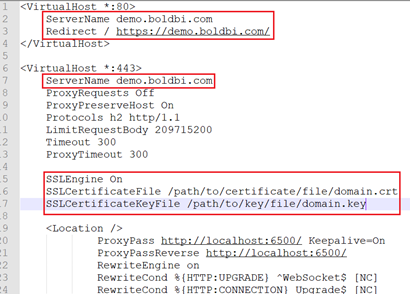Deploy Bold BI on Ubuntu Using Apache Server
To deploy Bold BI with Apache server on your Linux machine, execute the following command:
sudo bash install-boldbi.sh -i {new} -u {user} -h {host URL} -s apache -
i: Installation type: Specifies whether it is a new or upgrade installation.
-
u: Specify the user or group that manages the service.
-
h: Domain or IP address of the machine with HTTP protocol.
-
s: Setting this to “apache” will automatically configure Bold BI with the Apache server.
IMPORTANT: If there are any existing applications running on the Linux machine using Apache, set the “-n” value to false and configure Apache manually.
Example for new installation:
sudo bash install-boldbi.sh -i new -u www-data -h http://linux.example.com -s apache
Once the installation is completed, open the host URL in the browser and continue with the application startup.
Manually Configure Apache
To configure Apache as a reverse proxy to forward requests to the Bold BI app, modify the /etc/apache/sites-available/000-default.conf file. Open it in a text editor and add the following code.
<VirtualHost *:80>
#ServerName localhost
#Redirect / https://localhost/
#</VirtualHost>
#<VirtualHost *:443>
#ServerName localhost
ProxyRequests Off
ProxyPreserveHost On
Protocols h2 http/1.1
LimitRequestBody 209715200
Timeout 300
ProxyTimeout 300
#SSLEngine On
#SSLCertificateFile /path/to/certificate/file/domain.crt
#SSLCertificateKeyFile /path/to/key/file/domain.key
<Location />
ProxyPass http://localhost:6500/ Keepalive=On
ProxyPassReverse http://localhost:6500/
RewriteEngine on
RewriteCond %{HTTP:UPGRADE} ^WebSocket$ [NC]
RewriteCond %{HTTP:CONNECTION} Upgrade$ [NC]
RewriteRule /(.*) ws://localhost:6500/$1 [P]
RequestHeader set "X-Forwarded-Proto" expr=%{REQUEST_SCHEME}
</Location>
<Location /api>
ProxyPass http://localhost:6501/api Keepalive=On
ProxyPassReverse http://localhost:6501/api
RewriteEngine on
RewriteCond %{HTTP:UPGRADE} ^WebSocket$ [NC]
RewriteCond %{HTTP:CONNECTION} Upgrade$ [NC]
RewriteRule /api/(.*) ws://localhost:6501/api/$1 [P]
RequestHeader set "X-Forwarded-Proto" expr=%{REQUEST_SCHEME}
</Location>
<Location /ums>
ProxyPass http://localhost:6502/ums Keepalive=On
ProxyPassReverse http://localhost:6502/ums
RewriteEngine on
RewriteCond %{HTTP:UPGRADE} ^WebSocket$ [NC]
RewriteRule /ums/(.*) ws://localhost:6502/ums/$1 [P]
RequestHeader set "X-Forwarded-Proto" expr=%{REQUEST_SCHEME}
</Location>
<Location /ums/signalr/progresshub>
RewriteEngine on
RewriteCond %{HTTP:UPGRADE} ^WebSocket$ [NC]
RewriteCond %{HTTP:CONNECTION} Upgrade$ [NC]
RewriteRule /ums/signalr/progresshub(.*) ws://localhost:6502/ums/signalr/progresshub$1 [P]
RequestHeader set "X-Forwarded-Proto" expr=%{REQUEST_SCHEME}
</Location>
<Location /bi>
ProxyPass http://localhost:6504/bi Keepalive=On
ProxyPassReverse http://localhost:6504/bi
RewriteEngine on
RewriteCond %{HTTP:UPGRADE} ^WebSocket$ [NC]
RewriteRule /bi/(.*) ws://localhost:6504/bi/$1 [P]
RequestHeader set "X-Forwarded-Proto" expr=%{REQUEST_SCHEME}
</Location>
<Location /bi/messageHub>
RewriteEngine on
RewriteCond %{HTTP:UPGRADE} ^WebSocket$ [NC]
RewriteCond %{HTTP:CONNECTION} Upgrade$ [NC]
RewriteRule /bi/messageHub(.*) ws://localhost:6504/bi/messageHub$1 [P]
RequestHeader set "X-Forwarded-Proto" expr=%{REQUEST_SCHEME}
</Location>
<Location /bi/api>
ProxyPass http://localhost:6505/bi/api Keepalive=On
ProxyPassReverse http://localhost:6505/bi/api
RewriteEngine on
RewriteCond %{HTTP:UPGRADE} ^WebSocket$ [NC]
RewriteCond %{HTTP:CONNECTION} Upgrade$ [NC]
RewriteRule /bi/api/(.*) ws://localhost:6505/bi/api/$1 [P]
RequestHeader set "X-Forwarded-Proto" expr=%{REQUEST_SCHEME}
</Location>
<Location /bi/jobs>
ProxyPass http://localhost:6506/bi/jobs Keepalive=On
ProxyPassReverse http://localhost:6506/bi/jobs
RewriteEngine on
RewriteCond %{HTTP:UPGRADE} ^WebSocket$ [NC]
RewriteCond %{HTTP:CONNECTION} Upgrade$ [NC]
RewriteRule /bi/jobs/(.*) ws://localhost:6506/bi/jobs/$1 [P]
RequestHeader set "X-Forwarded-Proto" expr=%{REQUEST_SCHEME}
</Location>
<Location /bi/designer>
ProxyPass http://localhost:6507/bi/designer Keepalive=On
ProxyPassReverse http://localhost:6507
RewriteEngine on
RewriteCond %{HTTP:UPGRADE} ^WebSocket$ [NC]
RewriteRule /bi/designer/(.*) ws://localhost:6507/bi/designer/$1 [P]
RequestHeader set "X-Forwarded-Proto" expr=%{REQUEST_SCHEME}
</Location>
<Location /bi/designer/helper>
RewriteEngine on
RewriteCond %{HTTP:UPGRADE} ^WebSocket$ [NC]
RewriteCond %{HTTP:CONNECTION} Upgrade$ [NC]
RewriteRule /bi/designer/helper(.*) ws://localhost:6507/bi/designer/helper$1 [P]
RequestHeader set "X-Forwarded-Proto" expr=%{REQUEST_SCHEME}
</Location>
</VirtualHost>
Once the Apache configuration is established, run sudo apache2ctl configtest to verify the syntax of the configuration files. If the configuration file test is successful, force Apache to pick up the changes by running sudo systemctl restart apache2.
Configure SSL for Apache server
If you have an SSL certificate for your domain and need to configure the site with it, follow these steps or you can skip this:
-
Uncomment the marked lines in the Apache config file.

-
Replace “localhost” with your domain.
-
Define the path of the SSL certificate:
ssl_certificate /etc/ssl/domain.crt. -
Specify the directory where the SSL certificate key is located:
ssl_certificate_key /etc/ssl/domain.key.
-
Save the changes and run
sudo apache2ctl configtestto verify the syntax of the configuration file. If the configuration file test is successful, force Apache to pick up the changes by runningsudo apache2ctl restart.
NOTE: If you are configuring the application with SSL, you need to update the URLs in the product.json file with
HTTPS, located in/var/www/boldbi-embedded/boldbi/app_data/configuration.